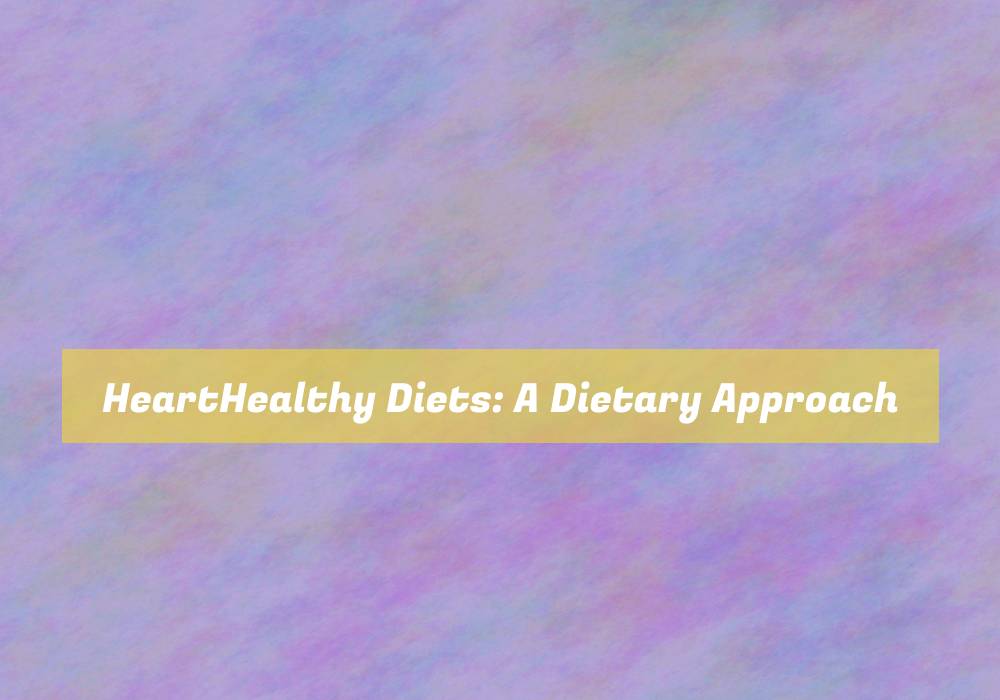HeartHealthy Diets: A Dietary Approach
When it comes to taking care of your heart, the right diet can be like a shield, protecting it from harm and keeping it strong. But how do you create a diet that truly supports heart health?
What are the key principles and foods you should focus on? And how can you adopt these changes into your daily routine without feeling overwhelmed?
LetG??s explore the essential components of a heart-healthy diet and how you can make simple yet impactful changes to nourish your heart.
Understanding Heart-Healthy Diets
To truly understand heart-healthy diets, you need to cut through the noise and focus on the essentials of nutrition and lifestyle choices. ItG??s essential to prioritize whole foods such as fruits, vegetables, whole grains, lean proteins, and healthy fats. These foods are rich in vitamins, minerals, and antioxidants, all of which contribute to a healthy heart. Limiting processed foods, added sugars, and excessive salt is also crucial. By doing so, you can reduce the risk of developing heart disease and high blood pressure.
In addition to dietary choices, regular physical activity is vital for maintaining a healthy heart. Aim for at least 150 minutes of moderate-intensity exercise per week, such as brisk walking, cycling, or swimming. Exercise not only helps control weight, reduce stress, and boost overall cardiovascular health, but it also improves blood circulation and reduces the risk of heart-related conditions.
Furthermore, managing stress and getting an adequate amount of quality sleep are integral parts of a heart-healthy lifestyle. Chronic stress and poor sleep can negatively impact heart health, so incorporating stress-reducing activities and establishing a consistent sleep schedule are essential for overall well-being. By prioritizing these aspects of nutrition and lifestyle, you can achieve and maintain a heart-healthy diet and reduce the risk of heart disease.
Key Principles for Heart Health
Prioritize incorporating whole foods such as fruits, vegetables, whole grains, lean proteins, and healthy fats into your diet to maintain a healthy heart. Whole foods are rich in nutrients and antioxidants that support heart health. Aim to fill your plate with a variety of colorful fruits and vegetables, as they provide essential vitamins, minerals, and dietary fiber. Opt for whole grains like oats, quinoa, and brown rice, which offer fiber and nutrients that can help lower cholesterol and reduce the risk of heart disease.
Choose lean proteins such as poultry, fish, beans, and legumes to limit saturated fat intake and promote heart health. Additionally, include healthy fats from sources like avocados, nuts, seeds, and olive oil, which can help lower bad cholesterol levels.
Incorporating these whole foods into your diet can help you maintain a healthy weight, lower blood pressure, and reduce the risk of developing heart disease. By prioritizing these key principles for heart health, you can support your overall well-being and reduce the likelihood of heart-related issues in the future.
Foods to Emphasize and Include
As you focus on building a heart-healthy diet rich in whole foods, itG??s essential to emphasize and include specific types of nourishing foods that offer significant benefits for your heart health.
First and foremost, emphasize the consumption of fruits and vegetables. These are packed with essential vitamins, minerals, and antioxidants that support heart health. Aim for a variety of colors to ensure youG??re getting a wide range of nutrients.
Additionally, include whole grains such as brown rice, quinoa, and oats. These are high in fiber, which can help lower cholesterol and improve overall heart health.
Furthermore, emphasize the inclusion of fatty fish like salmon, mackerel, and sardines, as theyG??re rich in omega-3 fatty acids that have been shown to reduce the risk of heart disease.
Nuts, seeds, and legumes are also excellent choices to include in your heart-healthy diet. They provide healthy fats, protein, and fiber, all of which contribute to cardiovascular health.
Strategies for Adopting a Heart-Healthy Diet
Consider incorporating small changes into your daily eating habits to gradually adopt a heart-healthy diet. Start by adding more fruits and vegetables to your meals. Instead of aiming for a complete overhaul of your diet, begin by swapping out unhealthy snacks for healthier options, such as nuts, seeds, or fresh fruit. Another strategy is to gradually reduce your intake of saturated fats by choosing leaner cuts of meat and opting for healthier cooking methods like grilling, baking, or steaming. Additionally, try to incorporate more whole grains into your meals, such as brown rice, quinoa, or whole grain bread.
ItG??s also important to pay attention to portion sizes. Be mindful of how much youG??re consuming and try to avoid oversized portions, which can lead to overeating. This can be as simple as using smaller plates or bowls to help control portion sizes.
Furthermore, be mindful of added sugars in your diet and consider cutting back on sugary beverages and processed foods. Lastly, make an effort to cook more meals at home using fresh, whole ingredients, as this gives you more control over what goes into your food. By making these small, gradual changes, you can successfully transition to a heart-healthy diet.
Conclusion
In conclusion, adopting a heart-healthy diet is crucial for maintaining cardiovascular health. By prioritizing fruits, vegetables, whole grains, lean proteins, and healthy fats, you can significantly reduce your risk of heart disease and other related conditions.
Remember to make small, sustainable changes to your eating habits and stay consistent in your efforts. Your heart will thank you for it in the long run.





